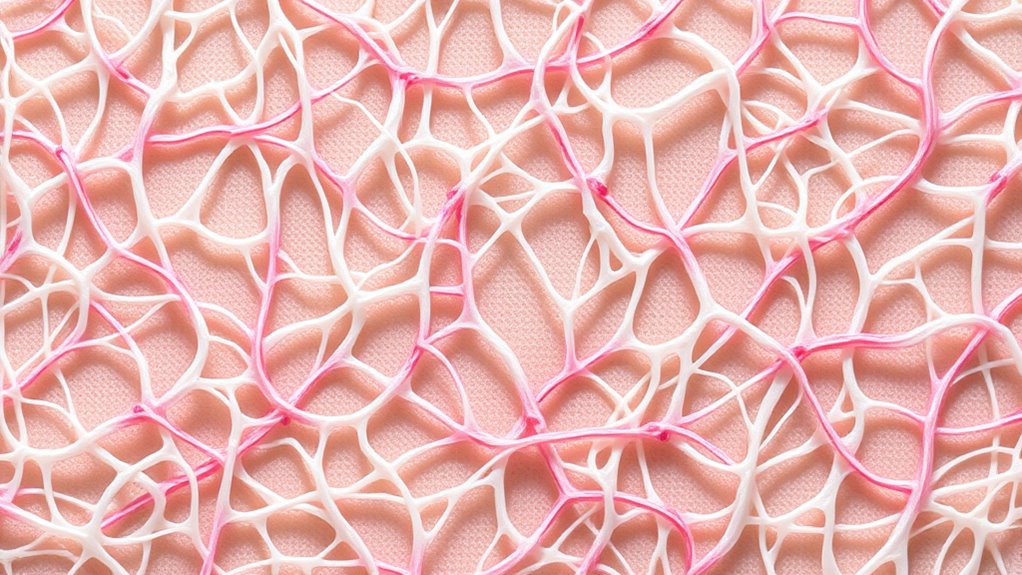Stretching alone isn’t enough when trauma affects your fascia, because it doesn’t target internal adhesions or scar tissue that limit movement and cause pain. While stretching can improve flexibility temporarily, it often fails to break down stubborn restrictions deep in your fascia. To truly heal and restore elasticity, manual therapy and targeted treatments are essential. Keep going to discover how proper approaches can help your fascia recover fully and reduce ongoing discomfort.
Key Takeaways
- Trauma causes fascia restrictions and scar tissue, which stretching alone often cannot fully resolve.
- Stretching improves flexibility but may not break down internal fascia adhesions or realign tissues.
- Manual therapy techniques target deeper fascia restrictions, promoting better healing than stretching alone.
- Proper diagnosis and targeted treatment are essential for effective fascia recovery after trauma.
- Combining manual therapy with stretching offers a more comprehensive approach to fascia healing and pain relief.

Have you ever considered how trauma can affect the fascia, the connective tissue that surrounds muscles and organs? When you experience injury or stress, it’s not just your muscles that suffer—it’s also your fascia. Trauma can cause the fascia to become tight, restricted, or even develop adhesions that limit movement and cause pain. This isn’t something that stretching alone can always fix. While stretching can help improve flexibility, it often doesn’t address the deeper issues within the fascia itself. That’s where fascia healing and manual therapy come into play.
Fascia healing is an essential part of recovering from trauma. When fascia gets damaged, it responds by forming scar tissue, which can become stiff and less elastic over time. This scarring can trap nerves or muscles, leading to persistent discomfort or restricted movement. Simply stretching might feel good temporarily, but if the fascia is still scarred or restricted, the problem will likely persist. To truly heal fascia, you need techniques that target the tissue at a deeper level—manual therapy is one such approach. Techniques like myofascial release or other hands-on treatments work by applying gentle pressure to break down adhesions, improve blood flow, and encourage proper fascia realignment.
Manual therapy isn’t just about loosening tight tissue; it actively stimulates fascia healing. When performed correctly, it helps restore the tissue’s natural glide and elasticity, which stretching alone might not accomplish. This hands-on approach allows the therapist to target specific areas where fascia has become restricted due to trauma. As the fascia begins to heal, you’ll notice improvements not only in flexibility but also in pain levels and overall movement. Additionally, understanding the importance of high-quality imaging can help identify the extent of fascia damage and guide targeted treatment plans. This process can be gradual, but consistent manual therapy supports more effective healing than stretching alone.
It’s important to recognize that fascia responds differently to trauma than muscles or skin. Trauma creates internal restrictions that require a specialized approach to resolve. Relying solely on stretching can sometimes mask symptoms rather than resolve the root cause. Incorporating manual therapy into your recovery plan ensures you’re addressing the fascia’s healing process directly. By doing so, you’re giving your body the best chance to restore full function, reduce pain, and prevent future injuries. Remember, fascia healing takes time and patience, but with targeted manual therapy, you’re actively promoting true recovery rather than just temporary relief.
Frequently Asked Questions
Can Fascia Trauma Cause Long-Term Chronic Pain?
Fascia trauma can indeed lead to long-term chronic pain. When your fascia loses elasticity due to injury or trauma, it may become stiff and restrict movement. This decreased fascia elasticity can cause persistent discomfort and pain that doesn’t resolve with simple stretching. Managing fascia trauma often requires targeted therapies to restore elasticity and address the underlying issues, helping prevent chronic pain and improve overall mobility.
How Do I Identify Fascia Damage Myself?
To identify fascia damage yourself, start with simple self-assessment techniques like fascia flexibility tests. Notice if certain areas feel tight, tender, or restricted during movement. Pay attention to persistent discomfort or limited range of motion, which may indicate fascia issues. Keep in mind that while these signs can guide you, consulting a professional for a thorough evaluation guarantees accurate diagnosis and effective treatment.
Are There Specific Exercises for Fascia Healing?
Think of your fascia as the foundation of a house—if it’s stiff or damaged, everything above suffers. To promote fascia healing, focus on exercises that improve fascia flexibility, like gentle stretching combined with myofascial release techniques. These movements help break down adhesions and restore elasticity. Consistent practice can gradually free your fascia, allowing your body to move more freely and reduce pain.
Does Fascia Trauma Affect Internal Organs?
Fascia trauma can indeed affect internal organs because of the organ connection through fascia. When fascia loses its elasticity, it can restrict movement and impact organ function. You might notice symptoms like pain or tension in areas connected by fascia. To support recovery, focus on increased fascia elasticity through targeted exercises, manual therapy, and mindful movement, which help restore the fascia’s natural glide and maintain healthy organ function.
What Professional Treatments Are Most Effective for Fascia Injuries?
You might think stretching is enough for fascia injuries, but professional treatments like fascial release and manual therapy often deliver better results. These techniques target deep tissue layers, breaking up adhesions and restoring mobility. Unlike passive stretching, they actively address underlying restrictions. If you want lasting relief, seek a skilled therapist who specializes in fascia work, ensuring your treatment is precise and effective, speeding up your recovery process.
Conclusion
So, as you’ve seen, trauma in the fascia isn’t just about stretching—it’s about understanding how everything’s connected. Sometimes, a simple stretch might seem enough, but coincidence shows that addressing underlying issues can make a real difference. Think of it like finding a missing puzzle piece—you might notice the discomfort, but uncovering the root causes brings everything into focus. Ultimately, taking an all-encompassing approach helps you move freely and feel better, just when you least expect it.










